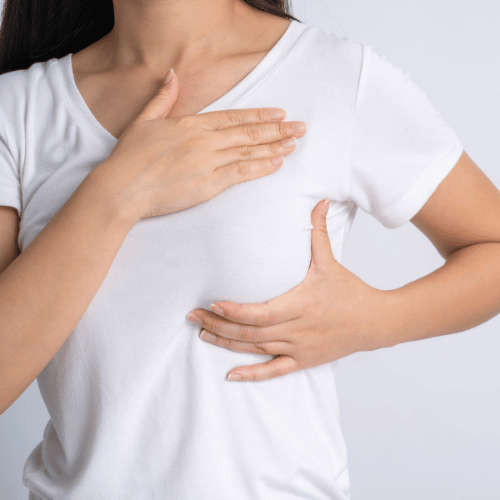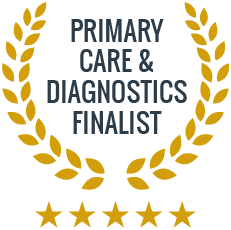
PCOS: Diagnosis, Research & Management
Polycystic Ovary Syndrome is a common endocrine disorder that affects people with ovaries, typically during their reproductive years.
Gynaecology > Breast Health

Find Out More


Women of all ages are encouraged to keep a close eye on their breast health, as invasive breast cancer is the most common cancer in the UK, affecting one in eight women over their lifetime.
If detected early, there is a much better chance of overcoming the disease, and thanks to greater awareness, survival rates are at an all-time high. Taking these steps can make a significant difference in your health and well-being.

When self-monitoring your breasts, be aware of any changes in size, feel, shape, or colour. Watch for dimpling, rashes, or discharge, as these can be warning signs. Swellings in the upper breasts or armpits are often benign but should be noted.
Breast lumps are common and usually result from inflammation, cysts, or benign conditions like fibroadenomas. If you are breastfeeding, lumps or abscesses may occur due to infection and can be treated with antibiotics.
It is normal to experience changes in breast tissue density, including lumps, in the week before your period. These typically resolve once your period starts. If you have concerns or notice persistent changes, consult a healthcare professional for reassurance.
Several factors can contribute to the risk of breast cancer. Age is a significant factor, with the risk increasing as you get older. Reproductive history, such as early menstruation, late menopause, or having no children, can also elevate risk. Genetic factors, including mutations in genes like BRCA1 and BRCA2, and a family history of breast cancer are important contributors.
Exposure to radiation, long-term use of hormone replacement therapy (HRT), and hormonal contraceptives can increase risk. Lifestyle choices such as smoking, excessive alcohol consumption, obesity, and a sedentary lifestyle further contribute to risk. A personal history of breast cancer or certain benign breast conditions can also be a factor. Understanding these elements can help in assessing and managing your risk.


Preventing breast cancer involves a combination of lifestyle changes and regular screenings. Key strategies include maintaining a healthy weight, engaging in regular exercise, and eating a balanced diet rich in fruits, vegetables, and whole grains while limiting alcohol and processed meats.
Avoiding smoking is also important. Regular breast cancer screenings, such as mammograms, are crucial for early detection. Understanding your family history and discussing genetic testing with your healthcare provider can help assess personal risk.
For those with a high risk, preventive measures like prophylactic surgery or medications may be considered.
Women of all ages are encouraged to monitor their breast health closely, but mammograms are especially important for women over 40 or those with a family history of breast cancer.
Use our online booking engine or book your test by giving us a call.
On the online booking engine select the “appointment type” you need.
You will be seen by one of our friendly doctors or trained clinicians.

To prepare for a mammogram, book your appointment outside the week before your period. Bring your medical history and previous mammogram records. On the day, avoid using deodorant or lotions, and wear a two-piece outfit. Inform our specialist of any breast pain, tenderness, or implants.

Our specialist will position you and adjust the machine. Your breast will be compressed between two plates to get clear X-Rays. You may feel some pressure briefly. Stay still and follow instructions. This is done for each breast.

After your mammogram, you can resume normal activities. Any discomfort from the compression should pass quickly. Results typically come within a week. If further tests are needed, you will be contacted.
Incorporated
in 1998
Experienced doctors & a professional team
Registration
not needed
Up-to-date with the latest treatments & testing
Strictly
confidential
Experienced doctors & a professional team
Affordable private
health care
Transparent fee structure with no hidden charges
We work with experienced consultants & healthcare professionals who have received positive feedback from our patients, and with whom we have established long-term relationships.
Latest Episode
Tune in to our podcast to explore the world of healthcare and learn from distinguished special guests. We cover everything from preventative measures to cutting-edge treatments so that you can stay informed and up-to-date on health-related things.

Polycystic Ovary Syndrome is a common endocrine disorder that affects people with ovaries, typically during their reproductive years.

Menopause is a natural biological process that marks the end of a woman’s reproductive years, typically occurring between ages 45

Learn about vaginal discharge: its role, what’s normal, and when to be concerned. Stay informed for optimal health.
Subscribe for latest updates & news


From same-day private GP and blood test appointments to visa medicals, a sexual and reproductive health clinic, and preventative health screenings, we are here to help.
Contact Us
Accepted Insurance Companies






Please note that Walk-in Clinic is a private medical centre & not an NHS service. Harley Walk-in Clinic Ltd company registration no. 07472804